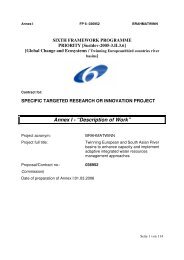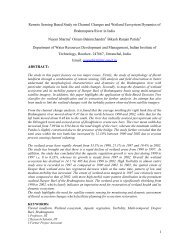WP 5 Analysis of present IWRM practices - Brahmatwinn
WP 5 Analysis of present IWRM practices - Brahmatwinn
WP 5 Analysis of present IWRM practices - Brahmatwinn
Create successful ePaper yourself
Turn your PDF publications into a flip-book with our unique Google optimized e-Paper software.
source within their premises in Assam, as many as 3,44,992 households draw water from tanks,<br />
ponds and lakes; 2,56,813 households from rivers and streams; 67,154 from springs and 49,631<br />
households from ‘any other’ sources (RGVN 2008). Millions <strong>of</strong> people in the country suffer from<br />
water-borne diseases on account <strong>of</strong> lack <strong>of</strong> access to safe drinking water. It is the poor who suffer<br />
most because in most cases, water-borne diseases originate in and enter the human body through<br />
unsafe water. Besides, in most <strong>of</strong> the State the groundwater has high iron content and high fluoride<br />
content. In recent decades the problem <strong>of</strong> arsenic in groundwater has affected many areas <strong>of</strong> the<br />
region. As groundwater constitutes a major part <strong>of</strong> the drinking water supply, this problem requires<br />
urgent attention from the concerned authorities. The issue <strong>of</strong> water quality has gained nation-wide<br />
importance during the last decade and a national authority, the Water Quality Assessment Authority,<br />
has been constituted by the Government <strong>of</strong> India, chaired by the Secretary, Ministry <strong>of</strong> Environment<br />
and Forests. The Water Quality Assessment Authority has constituted state-level water quality<br />
review committees chaired by the secretaries or commissioners <strong>of</strong> the concerned state departments.<br />
Tab. 8: Total gross and net water demands by 2050 in Assam<br />
Sector Gross demand<br />
(bcm) a<br />
Consumption Net demand<br />
(%)<br />
(bcm) a<br />
Domestic water supply<br />
Rural, domestic 2.920 - -<br />
Rural. Livestock 0.694 - -<br />
Total rural 3.614 50 1.807<br />
Urban 1.533 30 0.459<br />
Subtotal domestic(1) 5.147 - 2.266<br />
Industrial(2) 5.147 20 1.060<br />
Agricultural water supply - - -<br />
Surface water 35.200 44 15.500<br />
Irrigation - - -<br />
Groundwater 16.900 50 8.500<br />
Subtotal agriculture(3) 52.100 - 24.300<br />
Total (1+2+3) 62.394 27.630<br />
bcm = billion cubic meters<br />
(MOHILE 2001).<br />
A gross demand <strong>of</strong> 62.4 billion cubic meters and a net demand <strong>of</strong> 27.6 billion cubic meters have been<br />
projected by 2050 for meeting domestic, industrial, livestock, and agricultural requirements in north<br />
east India (table). The dependable flow <strong>of</strong> the Brahmaputra and Barak in the lean flow period is<br />
estimated to be in the order <strong>of</strong> 3,000 cubic meters per second and 45 cubic meters per second<br />
respectively at their exit points. The total groundwater potential <strong>of</strong> the two sub basins, at about 31<br />
billion cubic meters per year, can support, for 240 days per year, a draft <strong>of</strong> about 1,500 cubic meters<br />
per second. From a simple hydrological point <strong>of</strong> view, the groundwater draft may in the long run lead<br />
to more reduction in surface flows. But together, from both sources, about 3,000 cubic meters per<br />
second <strong>of</strong> water is available (MOHILE 2001). The net withdrawal from the 11 system, including<br />
groundwater, would be in the order <strong>of</strong> 239 cubic meters per second in February, which is lower than<br />
30





